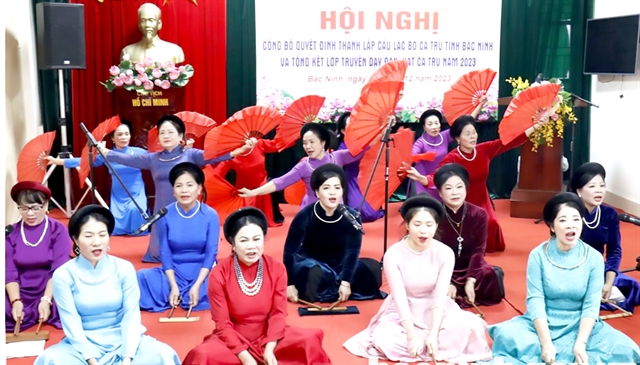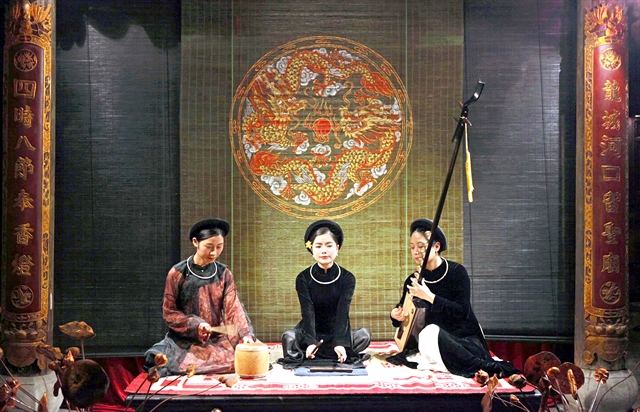
Members of a ca trù training class perform at a conference held recently to announce the decision to establish the Bắc Ninh Ca Trù Club. Photo bacninh.gov.vn
BẮC NINH — The cultural authority in the northern province of Bắc Ninh has launched a club to preserve and promote ca trù (ceremonial singing) recognised by UNESCO in 2009 as an intangible cultural heritage in urgent need of safeguarding.
With a total 45 members, the Bắc Ninh Ca Trù Club is responsible for training, organising and developing the ca trù singing movement in the province.
It will also help preserve and promote the intangible cultural values of ca trù; provide training courses for improving members' professional performance quality; and discover and nurture key talents of singers and performers to participate in competitions and performances during festivals and local celebrations.
Bắc Ninh's Department of Culture, Sports and Tourism recently held a conference to announce a decision on the provincial club establishment and at the same time review this year's training programme for the folk singing across the province.
A ca trù singing class was opened in September this year with 37 students who were also members of ca trù clubs in different localities such as Thanh Khương Ward in Thuận Thành District, Đông Tiến in Yên Phong and Tiểu Than in Gia Bình.
In the class, students were taught singing and performing skills, how to play the đàn đáy (three-stringed plucked lute) and how to use the beat. The class also provided students with the knowledge and skills to methodically practise playing some traditional instruments.
All the students have successfully completed their studies and have been granted certifications for their participation.
The class has made a contribution to implementing the provincial project on promoting cultural heritage values associated with tourism development in the 2021-25 period, orientation to 2030.
In 2009, ca trù was recognised by UNESCO as an Intangible Cultural Heritage in need of urgent protection.
Bắc Ninh Province has three localities of Thanh Khương Ward, the two villages of Tiểu Than and Thượng Thôn that maintain ca trù clubs. Recently, a number of more clubs have been spontaneously set up to teach, exchange and perform ca trù as well as performing at public art festivals and competitions.
However, the province's cultural authority found that conservation activities face many difficulties due to the lack of musical instruments. Many club members are elderly and there are not many venues for this type of traditional performance art.

A ca trù performance often includes lyricists of 'ca nương' or “đào” (female vocalists), 'kép đàn' (lute players) and 'quan viên' (drummers). — VNA/VNS Photo
Ca trù is a traditional and unique art form in the North of Việt Nam. It holds significance in many rituals, belief practices, literature and other traditions that embodied the spiritual and philosophical system of the Vietnamese people.
In different regions, the folk singing has different names such as ả đào, cô đầu and nhà trò. No one knows exactly when it was founded, except for the fact that the music genre flourished in the 15th century.
Ca trù was associated with the activities of guilds and groups of singers and was often performed in cultural activities in the village and commune community, such as ceremonies worshiping the village tutelary god in communal houses, or in temples, shrines, professional ancestor worshipping houses and singing houses.
Later, it was performed at diplomatic receptions and ceremonies in royal places and loved by the nobility and intellectuals.
It has a rich and diverse singing style and songs are mainly from Vietnamese poetic forms. The words and lyrics are meaningful, poetic, emotional and profound. They are from romantic, epic, philosophic and teaching genres.
In ca trù singing, the lyricists, ca nương or đào (vocalists), kép đàn (lute players) and quan viên (drummers) are usually writers, intellectuals or talented people in poetry and music. VNS
OVietnam